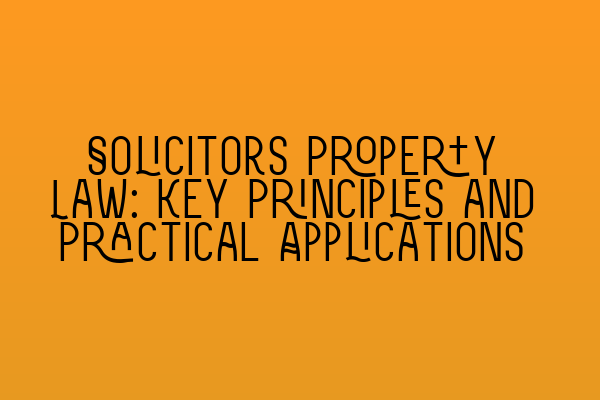Solicitors Property Law: Key Principles and Practical Applications
As a solicitor specializing in property law, it is essential to understand and apply the key principles that govern this area of legal practice. Property law is a broad field that encompasses various aspects of real estate, including ownership, transfer, and use of land and buildings.
In this blog post, we will explore the fundamental principles of property law and discuss their practical applications in real-life scenarios. Whether you are a solicitor looking to brush up on your knowledge or a law student preparing for the Solicitors Qualifying Exam (SQE), this guide will provide you with valuable insights to navigate the intricacies of property law.
The Nature of Property Rights
The concept of property rights lies at the heart of property law. Understanding the nature of these rights is crucial in determining the legal status and ownership of land and buildings.
Property rights can be divided into two categories: real property and personal property. Real property refers to immovable assets such as land and anything permanently attached to it, such as buildings and fixtures. On the other hand, personal property includes movable assets like furniture, vehicles, and personal belongings.
One of the key principles in property law is that real property rights are considered more robust and enduring compared to personal property rights. Land is often referred to as “immoveable property” due to its fixed nature, which gives rise to a higher level of legal protection.
Types of Property Ownership
Property ownership can take various forms, each with its specific legal implications. The main types of property ownership in England and Wales are freehold, leasehold, and commonhold.
Freehold: Freehold ownership grants the owner complete and indefinite rights over the property. This means that the owner has both the right to possession and use of the land, as well as the right to dispose of it as they see fit. Freehold ownership is often associated with houses and certain commercial properties.
Leasehold: Leasehold ownership, on the other hand, involves a contractual arrangement with the freehold owner. In this case, the leaseholder has a temporary right to occupy and use the property for a specified period, as outlined in the lease agreement. Leasehold properties are commonly found in apartment buildings and some commercial premises.
Commonhold: Commonhold is a relatively new form of property ownership in England and Wales. It allows for multiple individuals to own units within a building or development, while also having a share in the common areas and facilities. Commonhold is particularly prevalent in shared residential properties and has distinct legal requirements.
Conveyancing: The Process of Property Transfer
When it comes to property transactions, solicitors play a critical role in facilitating the transfer of ownership from one party to another. This process, known as conveyancing, involves multiple steps and legal requirements that safeguard the interests of all parties involved.
Typically, conveyancing begins with the negotiation and acceptance of an offer to purchase the property. Once the terms are agreed upon, the solicitor undertakes a series of searches and due diligence to ensure there are no issues or encumbrances affecting the property. These searches may include local authority searches, environmental searches, and land registry checks.
Following the completion of searches, the solicitor prepares and exchanges contracts, which outline the terms and conditions of the sale. This stage is crucial as it solidifies the legal obligations of both the buyer and seller. Finally, upon completion, the solicitor registers the new ownership with the land registry, officially transferring the property to the buyer.
Landlord and Tenant Law
Property law also encompasses landlord and tenant relationships, particularly in the context of leasing properties. Landlord and tenant law governs the rights and obligations of both parties, ensuring a fair and balanced approach to property rental.
For landlords, it is essential to understand the legal requirements for drafting and executing tenancy agreements, as well as the procedures for rent collection and property maintenance. On the other hand, tenants should be aware of their rights, such as the right to quiet enjoyment, reasonable notice for rent increases, and proper notice for eviction.
By familiarizing themselves with landlord and tenant law, solicitors can effectively represent their clients’ interests and provide sound legal advice for both parties involved in a tenancy agreement.
In Conclusion
Property law is a multifaceted area of legal practice that requires a deep understanding of its key principles and their practical applications. Whether you are a solicitor specializing in property law or a law student preparing for the SQE, staying up to date with current laws and regulations is vital for providing effective legal services.
At SQE Property Law & Land Law, we are dedicated to providing valuable resources and insights for legal professionals and aspiring solicitors. Make sure to check out our related articles on balancing work and SQE preparation strategies, unlocking the secrets to passing the SQE exam, understanding the grading system in SQE, and more.
By staying informed and building a strong foundation in property law, solicitors can navigate complex legal issues and provide the best possible representation for their clients.
